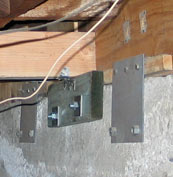JulianConstruction.com: Bolting Mudsills to a Cement Foundation
Do you know if your house is bolted to the foundation? Bolting is a type of seismic retrofitting that secures a home’s mudsill to its concrete foundation. Mudsill is the horizontal wood that sits on top of the foundation. It is the bottom of an exterior wall that connects the frame of the house to the footing.

Mudsills that aren’t connected to the foundation (or poorly connected) will start to move during a quake, along with the walls they are attached to. This motion can cause gas lines to break and electrical wires to pull out. Floors can also be damaged. If the shaking is severe, the entire building may end up collapsing.
When the mudsill is properly bolted to the concrete, it prevents the home from slipping and sliding during seismic activity.
Bolting a home to its foundation became a Uniform Building Code requirement in 1949. However, it took almost 10 years for local government to implement the code. Consequently, most homes built before 1960 have not been bolted to their foundations. Without bolting, an earthquake can shake the home off of its foundation.
You can check to see if your home’s mudsill has been bolted by going into your crawl space or basement and looking for thick bolts across the top of the sill. You should see bolts every 4 to 6 feet. There should also be steel anchor plates connecting the edge of the sill to the foundation’s side.
If you find any rusted bolts, they will need to be replaced. Rusted bolts are more common in moisture-prone areas.
Also look for recessed bolts. When the foundation is poured and bolts aren’t sticking up high enough, the mudsill around the bolt needs to be chiseled to get the nut on. This can make it difficult to tighten the nuts and virtually impossible for any anchor plates to be installed. Recessed bolts should be replaced.
An important point regarding bolting is the depth of penetration into the concrete. There are minimum and standard depth requirements depending on the type of anchor bolts being used.
Replacing bolts can be difficult because of the tight space. A foundation repair expert will know which bolts need to be replaced in addition to having all of the tools that will be needed to get the job done right.
Bolting is only one part of the retrofitting process. Even homes that are bolted can suffer severe damage from a quake if the cripple walls haven’t been braced properly. The cripple wall is the short wall between the first floor and the foundation. Cripple walls need reinforcement with sturdy materials like plywood. Stucco and wood siding does not provide enough support for the walls.
The best way to find out if your home is properly bolted, is to contact a foundation contractor, a specialist in this area, and ask for a free inspection. Getting help from a foundation repair (Los Angeles) expert will save you time, money and potential damage from the next big quake.
Julian De La Torre, expert in Los Angeles foundation inspection, repair & house bolting (Los Angeles) and founder of Julian Construction (www.julianconstruction.com) in Los Angeles, has inspected over 15,000 structures, working with engineering firms & local departments of building & safety. The company has done more home foundation repair (Los Angeles) than any other company in the area over the last five years. Julian Construction owns its own company and is a “no middlemen” model–no salesmen or subcontractors–you get the principals of the company & its workers under your home.
See their video:





